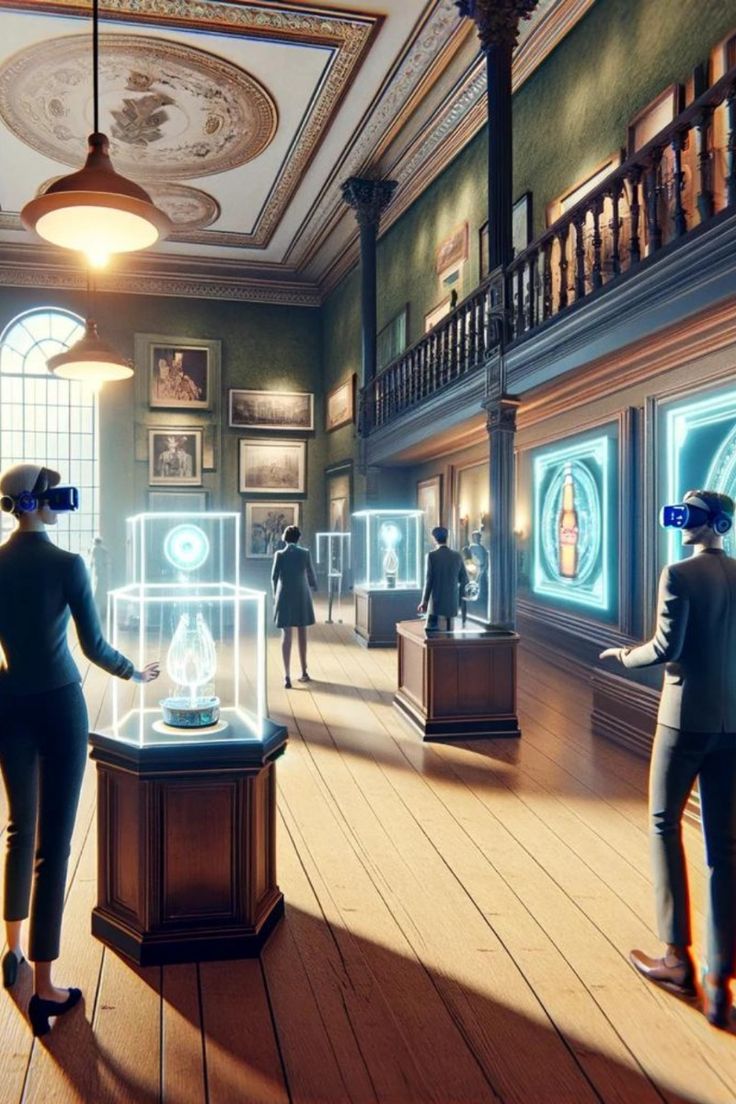Augmented Reality (AR) and Virtual Reality (VR): Shaping the Future of Technology in 2025
Augmented Reality and Virtual Reality: As we move into 2025, Augmented Reality (AR) and Virtual Reality (VR) are emerging as some of the most impactful technologies in a wide range of sectors. Whether it’s for entertainment, education, healthcare, or industrial applications, AR and VR are revolutionizing how we interact with the digital and physical worlds. These immersive technologies are not only enhancing user experiences but also creating new ways for businesses and individuals to engage with and visualize information.
In this article, we explore how AR and VR technologies have evolved by 2025, their transformative effects on different industries, and the future potential of these technologies.
What is Augmented Reality (AR)? Augmented Reality and Virtual Reality
Augmented Reality (AR) overlays digital content onto the real world, enhancing our perception of our surroundings by adding interactive elements to the physical environment. Unlike Virtual Reality, which creates a completely immersive virtual environment, AR augments the real world with virtual objects that appear to coexist with it in real-time. AR typically uses smartphones, tablets, and wearable devices like AR glasses or smart lenses to deliver this experience.
Examples of AR technology include: Augmented Reality and Virtual Reality
- Pokémon Go: The mobile game that blended the digital world of Pokémon with the real world.
- IKEA Place: An app that allows users to visualize furniture in their homes before purchasing.
- Google Maps AR Navigation: Provides real-time navigation directions with virtual markers overlaid onto real-world views.
What is Virtual Reality (VR)? Augmented Reality and Virtual Reality
Virtual Reality (VR), on the other hand, creates a completely digital and immersive environment that can be experienced using specialized headsets or glasses. These VR headsets, such as the Oculus Rift or HTC Vive, provide users with an immersive experience where they can interact with 3D virtual worlds as if they were physically present. VR technology can be used for entertainment, gaming, training, and various other professional applications.
Examples of VR technology include: Augmented Reality and Virtual Reality
- Gaming: Fully immersive video games like those on Oculus Quest that allow users to experience a game world with 360-degree views and hand-tracking.
- Virtual Tourism: VR allows people to experience travel destinations in an immersive way without leaving their homes.
- Medical Training: VR simulations are used for training doctors and medical professionals, providing hands-on experience in a risk-free, virtual setting.
Key Innovations in AR and VR (2025) Augmented Reality and Virtual Reality
As of 2025, AR and VR technologies have made significant advancements, offering more immersive, accessible, and versatile experiences. Below are some of the most notable innovations driving these technologies forward.
1. Enhanced AR Glasses and Wearables
In 2025, AR glasses have evolved from early prototypes to mainstream products. Companies like Apple, Microsoft, and Google have released high-quality, stylish, and functional AR glasses that provide users with a seamless experience, displaying information in their field of view without the need for a mobile device. These glasses can be used for navigation, entertainment, fitness, and even remote work, offering hands-free interaction with the digital world.
2. VR/AR Hybrid Systems: Augmented Reality and Virtual Reality
The combination of AR and VR, known as mixed reality (MR), is becoming more prevalent in 2025. Hybrid systems allow users to seamlessly switch between fully immersive VR experiences and augmented environments. Microsoft’s HoloLens 2, for example, enables real-time interaction with both physical and virtual elements, which can be especially useful for industries like engineering, healthcare, and design.
3. Haptic Feedback and Full-Body Motion Capture: Augmented Reality and Virtual Reality
One of the most exciting developments in AR and VR technology in 2025 is the integration of haptic feedback and full-body motion capture systems. Haptic feedback allows users to feel sensations in virtual environments, such as the texture of virtual objects or the impact of physical movements. Full-body motion capture, facilitated by advanced motion sensors and wearable suits, enables a more interactive experience, allowing users to physically interact with their virtual surroundings.
4. AR in Healthcare
In 2025, AR is revolutionizing the healthcare industry by providing medical professionals with real-time, augmented data during surgeries or diagnostic procedures. Surgeons can use AR headsets to visualize patient data, such as CT scans and X-rays, overlaid directly onto the patient’s body during surgery. This technology enhances precision, reduces risk, and improves patient outcomes.
5. VR for Mental Health and Therapy
Virtual reality is being utilized in 2025 for therapeutic purposes, particularly in mental health treatment. Exposure therapy using VR is helping individuals with conditions like PTSD, anxiety, and phobias by immersing them in controlled virtual environments where they can confront their fears in a safe and controlled setting. VR has also been used in pain management, providing patients with virtual escapes to help distract them from chronic pain.
6. Advanced Gaming and Entertainment Experiences
The gaming industry in 2025 is undergoing a revolution with VR and AR enhancing the way we play and experience interactive media. Virtual reality gaming has evolved into a fully immersive experience, with 360-degree visuals, motion sensing, and real-time interaction making players feel as though they are physically inside the game world. AR gaming is also expanding, offering games that integrate the real world with the virtual, creating new, innovative experiences.
Impact of AR and VR on Industries: Augmented Reality and Virtual Reality
AR and VR technologies are reshaping multiple industries by providing new ways of engaging with information, products, and services. Some key sectors benefiting from AR and VR advancements include:
1. Education: Augmented Reality and Virtual Reality
In education, VR allows students to explore virtual environments, such as historical landmarks or distant planets, without leaving the classroom. AR, on the other hand, enhances learning experiences by superimposing educational content on physical objects, such as anatomical structures in biology or interactive maps in geography. These immersive experiences can make learning more engaging, interactive, and accessible.
2. Retail and E-Commerce: Augmented Reality and Virtual Reality
In 2025, AR is being used by retailers to offer virtual try-on experiences, allowing customers to see how clothing, accessories, or makeup will look on them before making a purchase. This reduces the uncertainty associated with online shopping and enhances customer satisfaction. VR is also being used to create virtual stores and immersive shopping experiences, enabling users to browse and purchase products from the comfort of their homes.
3. Real Estate: Augmented Reality and Virtual Reality
In real estate, VR is revolutionizing property tours. Instead of visiting properties in person, potential buyers can experience virtual walkthroughs of homes and commercial properties from anywhere in the world. AR is also being used in architectural design to visualize how buildings will look once completed by superimposing digital models onto physical locations.
4. Manufacturing and Design: Augmented Reality and Virtual Reality
AR is transforming industries like manufacturing and design by overlaying digital information onto physical environments. Designers and engineers can use AR to visualize prototypes, simulate assembly processes, and conduct real-time collaboration with teams located around the world. This increases efficiency, reduces errors, and enhances decision-making in product development.
5. Tourism and Travel: Augmented Reality and Virtual Reality
VR is enabling people to virtually travel to destinations before booking their trips, allowing them to explore locations and attractions in immersive detail. This enhances the travel planning experience and offers people a taste of what they can expect before making a decision. Additionally, AR is being used for guided tours, where users can point their smartphones at landmarks and receive contextual information and directions.
Benefits of AR and VR Technologies: Augmented Reality and Virtual Reality
The advancements in AR and VR technology offer a range of benefits for users and industries alike:
1. Immersive User Experiences: Augmented Reality and Virtual Reality
AR and VR create deeply immersive experiences that engage users in new and exciting ways. Whether it’s through gaming, education, or virtual tourism, these technologies allow people to experience digital content in a manner that feels real and interactive.
2. Enhanced Productivity and Collaboration: Augmented Reality and Virtual Reality
AR and VR are improving productivity and collaboration in professional settings. Workers can use AR for training, real-time collaboration, and troubleshooting, while VR enables remote teams to work together in virtual spaces, reducing the need for travel and boosting efficiency.
3. Increased Accessibility: Augmented Reality and Virtual Reality
AR and VR can make content and services more accessible, particularly for people with disabilities. For example, VR can be used in therapeutic settings to help patients with mobility challenges, while AR can provide assistance to those with visual impairments by overlaying helpful information or navigation cues.
4. Cost Savings: Augmented Reality and Virtual Reality
For industries such as healthcare, manufacturing, and real estate, AR and VR technologies are leading to significant cost savings by streamlining processes, reducing travel expenses, and improving training outcomes.
Challenges and Future Outlook; Augmented Reality and Virtual Reality
Augmented Reality and Virtual Reality: Despite the many advantages, AR and VR technologies still face challenges in 2025, including the high cost of hardware, the need for high-quality content, and concerns about privacy and data security. However, with continued innovation, these challenges are likely to be overcome, making AR and VR more accessible and impactful for a broader range of applications.
As the technologies continue to mature, we can expect to see even more groundbreaking applications of AR and VR across industries. Whether enhancing entertainment experiences, transforming the way we work, or revolutionizing education, AR and VR are undoubtedly shaping the future of how we experience and interact with the world around us.
The future of Augmented Reality (AR) and Virtual Reality (VR) is not just exciting—it’s already here, and the possibilities are endless.










